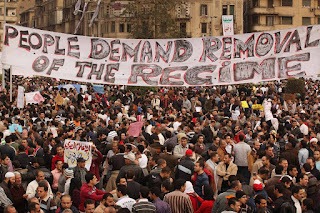History of the Middle East Part 4
On December 18, 2010, Mohamed Bouazizi, after being publicly humiliated by police officers at his vegetable stand in Tunisia, lit himself on fire. He died on January 4th, 2011. This sparked waves of protests in Tunisia, and after overcoming an initial media blackout, the Tunisian revolution had begun. On January 14th, Zine al-Abidine Ben Ali, ruler of Tunisia for 23 years, fled the country. A democratic regime is now largely thriving in Tunisia, and a liberal democracy seems to be an initial success in the small North African country.
This Tunisian revolution eventually morphed into protests all across the Arab world, known as the Arab Spring. For years, the vast majority of the Arab world had been ruled by corrupt and brutal dictators or kings. Tunisia, to the arab protestors, was an inspiration, and proof that protests could change how their world worked.
On January 25th, 2011, protesters in Cairo, in their “day of rage”, marched in the hundreds of thousands against the regime of Hosni Mubarak, which had lasted 30 years. Over the next few days, more protesters joined in, and on February 11th, Mubarak resigned, transferring power to the military. On June 24th, 2012, after the Egyptian presidential election, the Muslim brotherhood took power. The Muslim brotherhood is a very interesting group. Despite being an Islamist group, it is an enemy of Saudi Arabia, as the Saudis view the brotherhood as a threat to their regime. The Muslim brotherhood is closer to Turkey, and was supported by Turkey during the Egyptian elections. In fact, the Muslim brotherhood attempted to build an Islamic dictatorship in Egypt, similar to that of Erdogan’s in Turkey.
Large amounts of protest also occurred elsewhere in the Islamic world. Bahrain saw massive protests as the Shia majority attempted to dispose of the ruling Sunni government, and autocratic governments across the Arab world saw uprisings against them. Some were crushed by government forces, others resulted in reform. However, these uprisings ultimately did not change much, except for in Tunisia. The uprisings that will be mentioned below, however, did result in huge amounts of change, in the form of a civil war.
Yemen underwent a revolution of its own. On January 27th, 2011, thousands of Yemeni civilians took to the streets in protest against the government of Ali Abdullah Saleh, who had been in power for around 3 decades. By February of 2012, Saleh left office after over a year of massive protests. Unfortunately, this would eventually leave Yemen in a total state of anarchy. Saleh himself would end up siding with the Houthis during the Yemeni civil war.
Libya is a classic case of a power vacuum. On February 15th, 2011, anti-government protesters swarmed the streets of Libya. Rather than use anti-riot police, Gaddafi (who had ruled Libya with an iron fist for 42 years) elected to use military force, attacking protesters with helicopters and tanks. This, however, only resulted in more people joining the rebel cause, and parts of the military and Libya’s government begun to pledge their support for the rebellion. Over the next few months, Gaddafi’s position in Libya worsened, as he found himself an international pariah. In March, NATO enforced a no-fly zone over Libya and begun to bomb government held territory. By September, much of Libya had fallen to the rebels, leaving only the city of Sirte as a pro-Gaddafi stronghold. On October 20th, 2011, the war came to an end, as Gaddafi was killed and the last pro Gaddafi forces were eliminated. However, instead of a thriving democracy like that of Tunisia, Libya would quickly become a warzone with no central authority.
Syria is another case of the Arab spring gone wrong. After a group of school children who had sprayed anti-government graffiti onto a grain silo in Daraan were brutally beaten by Assad’s secret police, waves of protest swept across Syria. On March 25th, 2011, Syrian troops fired upon peaceful protestors, killing scores of people. On April 23rd, around 100 protesters were killed by government forces.. This only intensified anti-government sentiment. As crackdowns on dissent grew more brutal, several officers and soldiers defected from the Syrian government. This group then formed into the Free Syrian Army, which was the first armed group to fight against the Assad regime. This, of course, would rapidly lead to the Syrian Civil war.
2011 was also important in Iraq. To start with, all US troops were to be withdrawn from Iraq by the end of 2011. This led to massive amounts of instability, with a weak government and high tensions between Sunnis and Shias amid the Arab Spring. By late 2011, Iraq begun to fall apart again, with ISIS beginning to emerge as a potent fighting force, and Kurds in the north attempting to gain independence. Bombings and terror attacks escalated, and by 2014, Iraq would completely fall apart.



Comments
Post a Comment